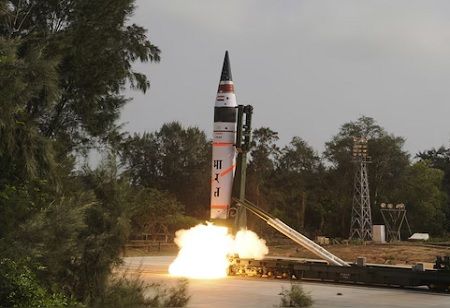
India Joins Global Missile Powers with MIRV Technology in Mission Divyastra

 India has entered the League of Nations possessing Multiple Independently Targetable Re-entry Vehicle (MIRV) technology following the successful inaugural flight test of the domestically developed Agni-5 missile under Mission Divyastra. This significant achievement places India alongside a select group of countries capable of deploying missiles with the capacity to deliver multiple warheads to separate targets.
India has entered the League of Nations possessing Multiple Independently Targetable Re-entry Vehicle (MIRV) technology following the successful inaugural flight test of the domestically developed Agni-5 missile under Mission Divyastra. This significant achievement places India alongside a select group of countries capable of deploying missiles with the capacity to deliver multiple warheads to separate targets.
On March 11, Prime Minister Narendra Modi praised the DRDO scientists for their accomplishment in Mission Divyastra, which heralded the debut flight test of the domestically manufactured Agni-5 missile, incorporating Multiple Independently Targetable Re-entry Vehicle (MIRV) technology.
According to strategic affairs expert Brahma Chellaney, India's nuclear deterrence has taken a major leap forward with the successful flight testing of an ICBM incorporating MIRV technology. Chellaney noted that the inclusion of MIRVs on the Agni 5 significantly boosts India's capability for a retaliatory strike against China, which is intensively engaged in augmenting its nuclear arsenal.
Multiple independently targetable Reentry Vehicles (MIRVs), developed first in the early 1960s, were designed to enable a missile to deliver multiple nuclear warheads to distinct targets. Unlike traditional missiles, which carry a single warhead, MIRVs have the capacity to transport multiple warheads. Warheads on missiles equipped with MIRVs can be deployed at varying speeds and directions, allowing for the targeting of locations up to 1,500 kilometers apart.
MIRV technology was first pioneered by the United States, with the introduction of a MIRV-equipped Intercontinental Ballistic Missile (ICBM) in 1970 and a MIRV-equipped Submarine-Launched Ballistic Missile (SLBM) in 1971. By the late 1970s, the Soviet Union had also developed its own MIRV-enabled ICBM and SLBM technology.
Currently, MIRV technology is utilized on Submarine-Launched Ballistic Missiles (SLBMs) by the United States, the United Kingdom, and France, while China has MIRV-equipped Intercontinental Ballistic Missiles (ICBMs). In January 2017, Pakistan purportedly conducted a test of a MIRVed missile named Ababeel. According to the Center for Arms Control and Non-Proliferation, the development of MIRV technology is a complex process that entails integrating large missiles, small warheads, precise guidance systems, and an advanced mechanism for sequentially releasing warheads during flight.